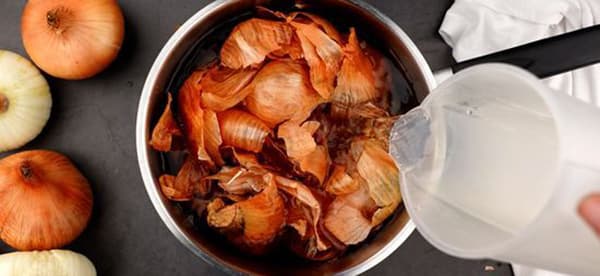
Don’t Throw Away Your Onion Skins, Do This Instead!
If you are trying to cut down on your trash, a good place to start is with your kitchen scraps. Onion is probably one of the kitchen staples that you cannot miss. Most dishes start and end with an onion. From sautéing to garnishing, who can skip the onion’s tangy flavor and delightful crunch?
But, what do you do with the onion peel?
Before you send them over to the bin, did you know that onion peels have a range of uses that benefits the environment and the body? Yes, the papery covering you easily ditch still has its value.
Onion peel is rich in quercetin, a flavonoid, that gives the plant amazing health benefits. Onion’s outer covering is an excellent anti-inflammatory, antiallergic, antioxidant, anti-depressive, anticancer, and anti-hypertensive.
Do not consider the onion peel an insignificant byproduct of the bulb. Here are some onion skin uses that are handy in zero-waste cooking.
13 Amazing Uses of Onion Peels
Low-Calorie Beverage
Onion peel tea is packed with vitamins and minerals but is totally low in calories. It is also fiber-rich, making it an excellent drink if you want to manage your weight. The soluble fiber of onion peels makes it a powerful prebiotic drink that you can sip guilt-free.
To concoct your low-cal drink, simply clean thoroughly onion peels from about 4 onions. You can add 5 grams of the skin to 250 ml of water. Bring the water to a slow boil, remove it from the heat, and steep for 5 to 6 minutes. You can add honey as a sweetener or enjoy the beverage as it is.
Thirst Quencher
Onion peel infusion is great for quenching a parched throat. If you have a bad cold, warm water alone may not suffice. Try sipping on onion-peel infusion and you might feel the difference. Plus, it has anti-inflammatory and antiviral properties that can ward colds away.
There is no need to light the stove in this one. Simply infuse or soak onion skin in a glass of water for 15 minutes, and remove the peel before drinking.
Treatment for Muscle Cramps
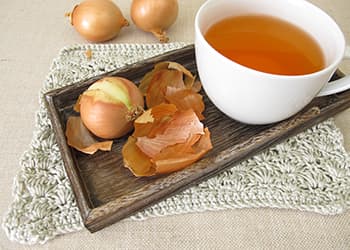
Onion peel tea is also a healing drink for muscle cramps. If you have annoying and recurring leg cramps, try sipping on a warm onion peel tea. Its anti-inflammatory action can effectively cure lingering muscle cramps and relax your whole body. Ideally, drink the tea before bedtime so you can sleep through the night without the agonizing leg pain.
Induce Sleep
Insomnia happens at the worst of times leaving us lethargic and less productive the following day. But, don’t let it ruin your sleep. Use the natural sleeping property of onion peel. Brewing onion skin in a cup of water and letting it steep for 15 minutes is great for inducing a good night’s sleep. It has L-tryptophan that can calm your nerves because of its natural sedative effect.
⇒ Why Put Onions in Your Socks Before Sleeping (Video)
Add Distinct Flavor to a Bread
The secret to good bread is the roll of tang and flavor, that is why we add herbs if we can. Adding onion skin to the dough before baking will give it more taste that is not as overpowering as an onion bulb. Mince the onion skin until powdery and add a teaspoon to the dough before baking to give it a savory flavor.
Improve the Appearance of Gravy
Adding onion peels to soup, sauces, and gravy helps thicken them and give them an appealing deep-brown hue. It is also a great timesaver as you can chop onion along with the peels and add them straight to the pot.
Enrich Rice
A rice meal does not need to be bland. Try adding a few onion skins when cooking and pick them out just before serving. Onion skin steeps its nutrients into the cooked rice while boosting it with flavor. It is also an excellent and healthy addition to fried rice and biryani.
Perfectly-Roasted Onion
Skinless roasted onions are limp and dry since the heat eliminates most of their tangy taste. But, keeping its skin while roasting preserves the juice and keeps its nutrients intact. The next time you are up for a barbecue, never bother with the onion skin anymore. Save your time and save its nutrients for a healthy kebab.
Dry Rub
Speaking of barbecue, smoking also brings out the flavor in food that is achieved through smoke and spices. For good taste, you need a dry rub of smoked spices for a punchy flavor. Onion peels go well with any spices for a dry rub, thanks to their versatile taste.
Turn your onion peel into a useful spice by turning them into ash. You can do this by roasting the onion peel in the oven until they are brittle and almost black. Grind it into powder and sprinkle over meat before roasting or smoking.
Natural Fertilizer
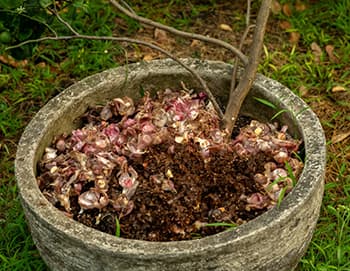
Onion peel is also beneficial for the garden. When added to compost, it balances the pH level in soil by lowering its acidity. It is also a rich source of calcium and potassium when added to mulch.
Alternatively, you can soak about two cups of onion skin in a liter of water for 24 hours. Strain it in a jar and use it as liquid fertilizer, feeding the plants 3 to 4 times a month.
Rooting Agent
Rooting agents ensure successful plant propagation, but there is no need to look for them elsewhere. All you need is a bowlful of onion skin, ground in a blender. Add about 4 to 5 spoons of aloe vera gel to make a paste, then dip your plant cuttings into it before planting.
Use It as a Dye
Onion skin leaches a natural purple hue and it is traditionally used as a dye because of its tannins. It can color fabric, wools, yarns, thread, Easter eggs, and even human hair! It is a natural, easy-to-make, and almost cost-free way of tinting some stuff.
Please note that the dye may yield different colors, not the rich purple of red onion. It depends on the amount of onion peel, the type of material, and the number of dips to saturate it.
The basic step in preparing the onion skin dye is simmering them in the saucepan for about 35 to 40 minutes. You can boil it longer if you want a richer color, then strain it. Allow some time for the dye to cool before using. Some textiles react to heat differently and alter their color.
⇒ 10 Ingenious Uses for Eggshells In Your Garden (Video)
Treat Skin Problems
Itchy skin and athlete’s foot are best remedied by onion peel. It has a potent antifungal property that alleviates itching and it can also reduce inflammation. You can apply onion skin infusion on the affected area, or use it as a soak for instant relief. You may also drink onion peel tea as a healing beverage.
Its combination of Vitamin C and E is best for the treatment of any skin problems. Just make sure not to skip any prescribed medications for your skin condition while using onion peel.
Conclusion
Onion is an indispensable herb for almost all types of cooking. When preparing our everyday meals, it is easy to overlook the importance of the onion peel. Fortunately, knowing its many benefits may make you think twice about throwing them away. So, keep a stash of onion skin and you will surely need them anytime soon.
DIY Onion Juice To Burn Belly Fat
How to Turn This Annoying Plant into a Vein Cleanser (Video)
13 Homemade Fertilizers for Your Plants

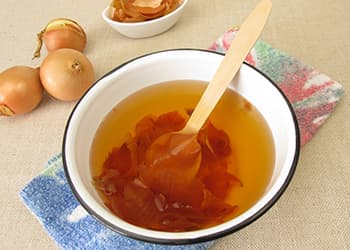
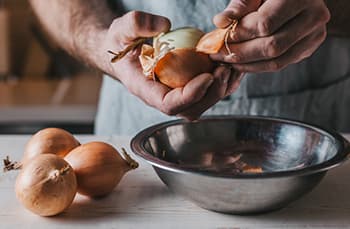
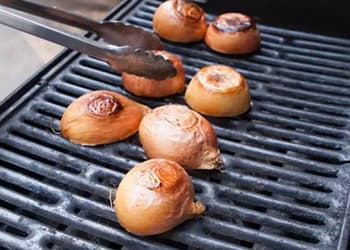
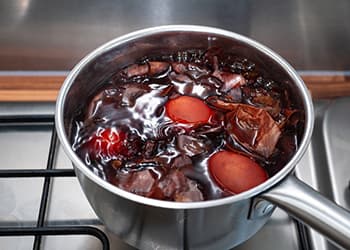

I include onion skins in the water when I boil eggs. The children know the colored eggs are hard boiled when looking for a snack.
Hi it is great to know that I love to hear more
My partner absolutely refuses to touch onions, and prefers that I not even think about them while cooking. I don’t particularly like them, so this is easy enough for me, but this article gives me a lot to think about. Usually I find that garlic is a perfect substitute for anything that requires onions, though obviously there are differences or we wouldn’t eat garlic. Still, I’m thrilled to learn new ways to use the garlic skins–usually I just toss them in the compost pile and hope the dog doesn’t drag too many of them away.
Consider putting all your vegetable scraps in a 5 gallon bucket with a little water. They will rot faster and you can mix some into any clippings you accumulate. If you live in a sunny climate then painting the bucket flat black will hurry the rotting along. And of course, the liquid is great fertilizer any plants. Good luck.
You can heat them up a bit then crush them to add to dishes. They’re delicious! And good for you.
If I don’t have enough onion skins to make anything currently, how do I store them so they don’t go off or go bad?
Hello Sue,
Thank you for your comment! Onion peels can be dried and kept in a sealed container for later use.
Dried onion skins are also a good addition to almost any dish.
Many blessings and good health!
You can also freeze them.
When dying fabric. Ammonia can be used to set the color so it doesn’t fade as much. Long ago, urine was used. I have also heard salt works some too but not sure. On a more tasty note, skins are often added to commercial chicken stock/broth to give it a more yellow appearance.
You state at the end to use an onion skin infusion for skin disorders but never instruct how to make the infusion. What did I miss?
An infusion is like a tea. Steep the herb in water for 5-10 minutes and then strain. That is an infusion.